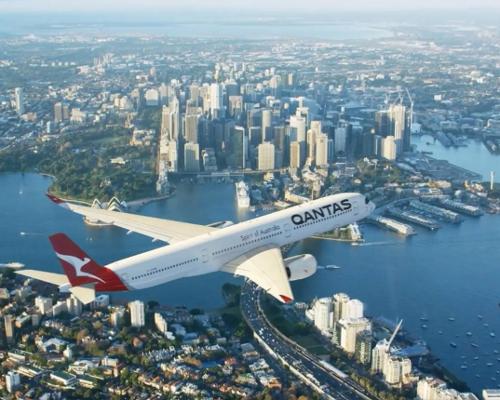21 Aug 2023
World’s first in-flight Wellbeing Zone to debut aboard Qantas' A350 in 2025 with workout options
BY Megan Whitby

Australian airline Qantas has introduced a Wellbeing Zone as part of the new cabin design for its Airbus A350.
Once Qantas adds 12 Airbus A350s to its fleet in late 2025, it claims it will be the first airline in the world to offer an in-flight wellness space that encourages guests to stretch, hydrate and spend time out of their seats.
The Wellbeing Zone will feature sculpted wall panels and integrated stretch handles, guided on-screen exercise programmes, a hydration station and a range of refreshments.
Developed as part of Project Sunrise, the A350 planes fly non-stop for up to 22 hours and enable flights from Australia to almost anywhere in the world, including from Sydney to New York.
Qantas Group CEO Alan Joyce said: “We started work on the Wellbeing Zone before any other area of the A350.
“The new Project Sunrise flights give us the opportunity to re-think long-haul travel in its entirety, from aircraft cabin design to what ingredients we include on the inflight menu.
“Reducing the number of seats onboard our A350 to 238 compared to the 300-plus seat layout of other carriers means we not only maximise aircraft performance across long distances but can also give our passengers more space and comfort and provide a dedicated Wellbeing Zone.
“We’re the only airline in the world that will have a bespoke designed onboard stretch and movement space.”
A new approach to wellness travel
Recent research conducted by Qantas – alongside the University of Sydney’s Charles Perkins Centre – shows that it is possible to reduce the impacts of jet lag by reshaping the inflight travel experience.
Different lighting and sleep schedules, mealtimes and specific ingredients during long-haul flights have been shown to contribute to improved traveller wellbeing. Movement and exercise are also key elements.
The research was conducted during test flights for Qantas’ Project Sunrise programme.
Qantas operated three Project Sunrise research flights from New York and London to Sydney in 2019 in partnership with Australian researchers to collect real-world passenger data.
Researchers travelled on the aircraft and monitored 23 volunteer customers who were fitted with wearable devices during the 20-hour flights as they followed a specially designed menu, lighting, sleep and movement sequences.
Initial findings, as yet unpublished, indicate that, compared to customers on a traditional inflight sequence of eating and sleeping, those on the tailored schedule experienced:
• Less severe jet lag (self-reported).
• Better sleep quality inflight.
• Better cognitive performance in the two days after the flight.
The inflight trials involved tailored cabin lighting schedules to facilitate adaptation to the destination time zone and integrating simple stretch and movement activities.
They also adjusted the timing of meal services to align the body clock and encouraged wake and sleep by using specific menu items including fish and chicken paired with fast-acting carbohydrates, as well as comfort foods like soups and milk-based desserts.
The aim was to promote the brain’s production of the amino acid tryptophan (‘Tryp’) to help passengers drift off more easily.
Peter Cistulli, professor of Sleep Medicine at the University of Sydney said while the research was ongoing, there were clear signs that the interventions implemented during the trial flights reduced the impact of ultra-long-haul travel.
Charles Perkins Centre and Qantas will take part in a first-ever combined lighting workshop at Airbus’ Hamburg headquarters later this year where specialists will design the lighting settings for the aircraft, including reviewing the optimal brightness and colour tone settings for each part of the flight.
Parallel research has been done to manage crew wellbeing on these flights, which also draws on experience from other ultra-long-haul flights operated by Qantas.
Close Window